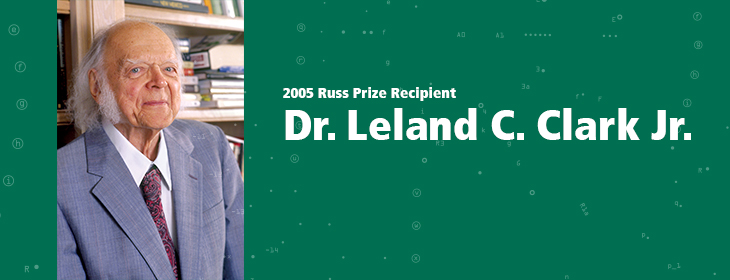2005 Russ Prize
Considered the "father of biosensors," Leland C. Clark Jr. invented the first device to rapidly determine the amount of glucose in blood. Today many of the 18.2 million Americans with diabetes rely on Clark's original glucose sensor concept for self-monitoring. In the future, an implantable biosensor - newly patented by Clark - could make blood glucose monitoring even easier by sending readings whenever needed.
The Clark Oxygen Electrode, which he invented in 1954, remains the standard for measuring dissolved oxygen in biomedical, environmental and industrial applications. The electrode quickly measures blood oxygen levels, enabling doctors to perform 750,000 open-heart surgeries each year. Oxygen monitoring is now a requirement for hospital accreditation. It is also used to measure oxygen levels in rivers and oceans to protect wildlife populations.
Clark's nontraditional, interdisciplinary approach to problem-solving has led to many breakthroughs. In addition to the implantable glucose electrode, his recent work has included research on a blood substitute and a breathable liquid. Clark was one of the founders of Synthetic Blood International Inc. He is a former University Distinguished Service Professor and Professor Emeritus, University of Cincinnati.
When Clark started high school and discovered that science was an academic discipline, complete with course work, lab sessions and grades, he said, "It was like discovering that you could get a grade for eating chocolate ice cream."
One of the few students to score a perfect 100 on the New York State Regents science exam, Clark attended Antioch College and the University of Rochester School of Medicine. Later, he taught at Antioch, the University of Cincinnati and the University of Alabama.
Clark has more than 80 inventions to his name - with medical applications that range from emergency room care to molecular research.
More than almost any single invention, the Clark Oxygen Electrode has revolutionized the field of medicine for the past 50 years. Allowing for the real-time monitoring of a patient's blood oxygen level, Clark's electrode has made surgery safer and more successful for millions of people throughout the world.
Introduced in 1956, the blood oxygen electrode quickly found a place in operating rooms and critical care facilities everywhere. Since then, its remarkable versatility has helped trigger advances in cell culture, molecular genetics, aviation and space flight, soil chemistry and even in wine and beer production.
In addition to the Clark Oxygen Electrode, he developed the first heart-lung machine that could be completely disassembled and sterilized, as well as the technology behind the glucose biosensor used by millions of diabetics and other patients every day.
For more than 30 years, Clark has pursued his dream of creating artificial blood. While making notable progress toward a solution, that technology remains in the very early stages of development.
In 1985, Leland Clark received the American Physiological Society's Hyrovsky Award, in recognition of the invention of the membrane polarographic oxygen electrode. He is a member of the National Academy of Engineering, National Association for Biomedical Research and the American Association for the Advancement of Science.
Meet Dr. Clark.
